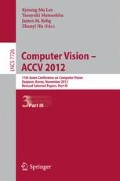Abstract
The occlusion in dynamic or clutter scene is a critical issue in multi-object tracking. Using latent variable to formulate this problem, some methods achieved state-of-the-art performance, while making an exact solution computationally intractable. In this paper, we present a hierarchical association framework to address the problem of occlusion in a complex scene taken by a single camera. At the first stage, reliable tracklets are obtained by frame-to-frame association of detection responses in a flow network. After that, we propose to formulate tracklets association problem in a spatio-temporal clustering model which presents the problem as faithfully as possible. Due to the important role that affinity model plays in our formulation, we then construct a sparsity induced affinity model under the assumption that a detection sample in a tracklet can be efficiently represented by another tracklet belonging to the same object. Furthermore, we give a near-optimal algorithm based on globally greedy strategy to deal with spatio-temporal clustering, which runs linearly with the number of tracklets. We quantitatively evaluate the performance of our method on three challenging data sets and achieve a significant improvement compared to state-of-the-art tracking systems.
Access this chapter
Tax calculation will be finalised at checkout
Purchases are for personal use only
Preview
Unable to display preview. Download preview PDF.
References
Amberg, B., Vetter, T.: Graphtrack: Fast and globally optimal tracking in videos. In: CVPR, pp. 1209–1216 (2011)
Andriluka, M., Roth, S., Schiele, B.: People-tracking-by-detection and people-detection-by-tracking. In: CVPR (2008)
Andriyenko, A., Schindler, K.: Multi-target tracking by continuous energy minimization. In: CVPR, pp. 1265–1272 (2011)
Andriyenko, A., Roth, S., Schindler, K.: An analytical formulation of global occlusion reasoning for multi-target tracking. In: ICCV Workshops, pp. 1839–1846 (2011)
Andriyenko, A., Schindler, K., Roth, S.: Discrete-continuous optimization for multi-target tracking. In: CVPR (2012)
Berclaz, J., Fleuret, F., Türetken, E., Fua, P.: Multiple object tracking using k-shortest paths optimization. IEEE Trans. Pattern Anal. Mach. Intell. 33, 1806–1819 (2011)
Cheng, H., Liu, Z., Yang, J.: Sparsity induced similarity measure for label propagation. In: ICCV, pp. 317–324 (2009)
Ess, A., Leibe, B., Gool, L.J.V.: Depth and appearance for mobile scene analysis. In: ICCV, pp. 1–8 (2007)
Felzenszwalb, P.F., McAllester, D.A., Ramanan, D.: A discriminatively trained, multiscale, deformable part model. In: CVPR (2008)
Huang, C., Wu, B., Nevatia, R.: Robust Object Tracking by Hierarchical Association of Detection Responses. In: Forsyth, D., Torr, P., Zisserman, A. (eds.) ECCV 2008, Part II. LNCS, vol. 5303, pp. 788–801. Springer, Heidelberg (2008)
Kuo, C.H., Nevatia, R.: How does person identity recognition help multi-person tracking? In: CVPR, pp. 1217–1224 (2011)
Leibe, B., Schindler, K., Gool, L.J.V.: Coupled detection and trajectory estimation for multi-object tracking. In: ICCV, pp. 1–8 (2007)
Pets, benchmark dataset (2009), http://www.cvg.rdg.ac.uk/PETS2009/a.html
Pirsiavash, H., Ramanan, D., Fowlkes, C.C.: Globally-optimal greedy algorithms for tracking a variable number of objects. In: CVPR, pp. 1201–1208 (2011)
Stalder, S., Grabner, H., Van Gool, L.: Cascaded Confidence Filtering for Improved Tracking-by-Detection. In: Daniilidis, K., Maragos, P., Paragios, N. (eds.) ECCV 2010, Part I. LNCS, vol. 6311, pp. 369–382. Springer, Heidelberg (2010)
Zhang, L., Li, Y., Nevatia, R.: Global data association for multi-object tracking using network flows. In: CVPR (2008)
Wu, B., Nevatia, R.: Tracking of multiple, partially occluded humans based on static body part detection. In: CVPR, vol. (1), pp. 951–958 (2006)
Author information
Authors and Affiliations
Editor information
Editors and Affiliations
Rights and permissions
Copyright information
© 2013 Springer-Verlag Berlin Heidelberg
About this paper
Cite this paper
Zhang, L., Wang, Q. (2013). Spatio-Temporal Clustering Model for Multi-object Tracking through Occlusions. In: Lee, K.M., Matsushita, Y., Rehg, J.M., Hu, Z. (eds) Computer Vision – ACCV 2012. ACCV 2012. Lecture Notes in Computer Science, vol 7726. Springer, Berlin, Heidelberg. https://doi.org/10.1007/978-3-642-37431-9_14
Download citation
DOI: https://doi.org/10.1007/978-3-642-37431-9_14
Publisher Name: Springer, Berlin, Heidelberg
Print ISBN: 978-3-642-37430-2
Online ISBN: 978-3-642-37431-9
eBook Packages: Computer ScienceComputer Science (R0)

